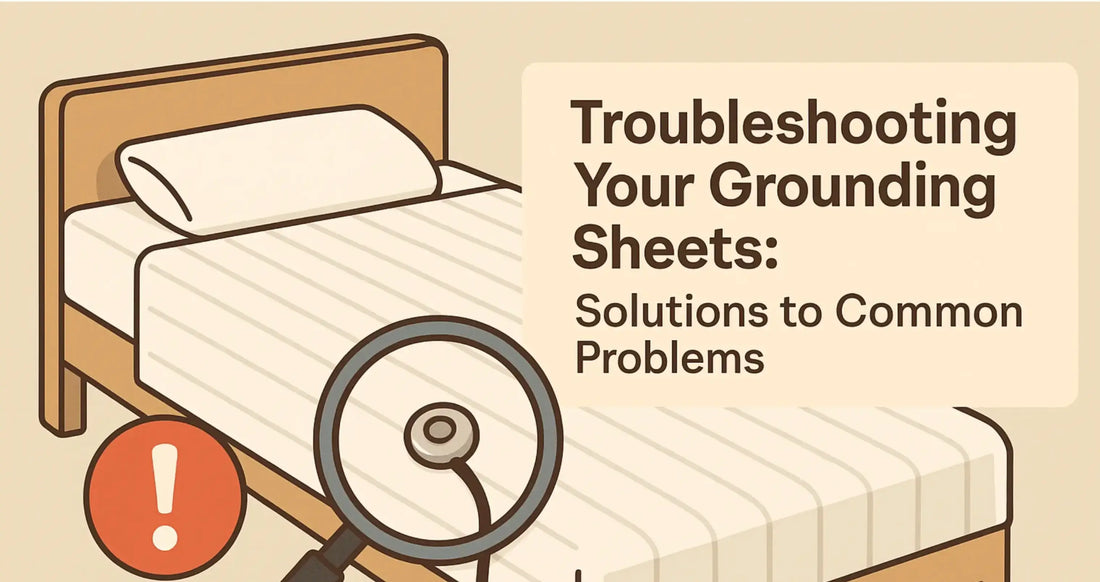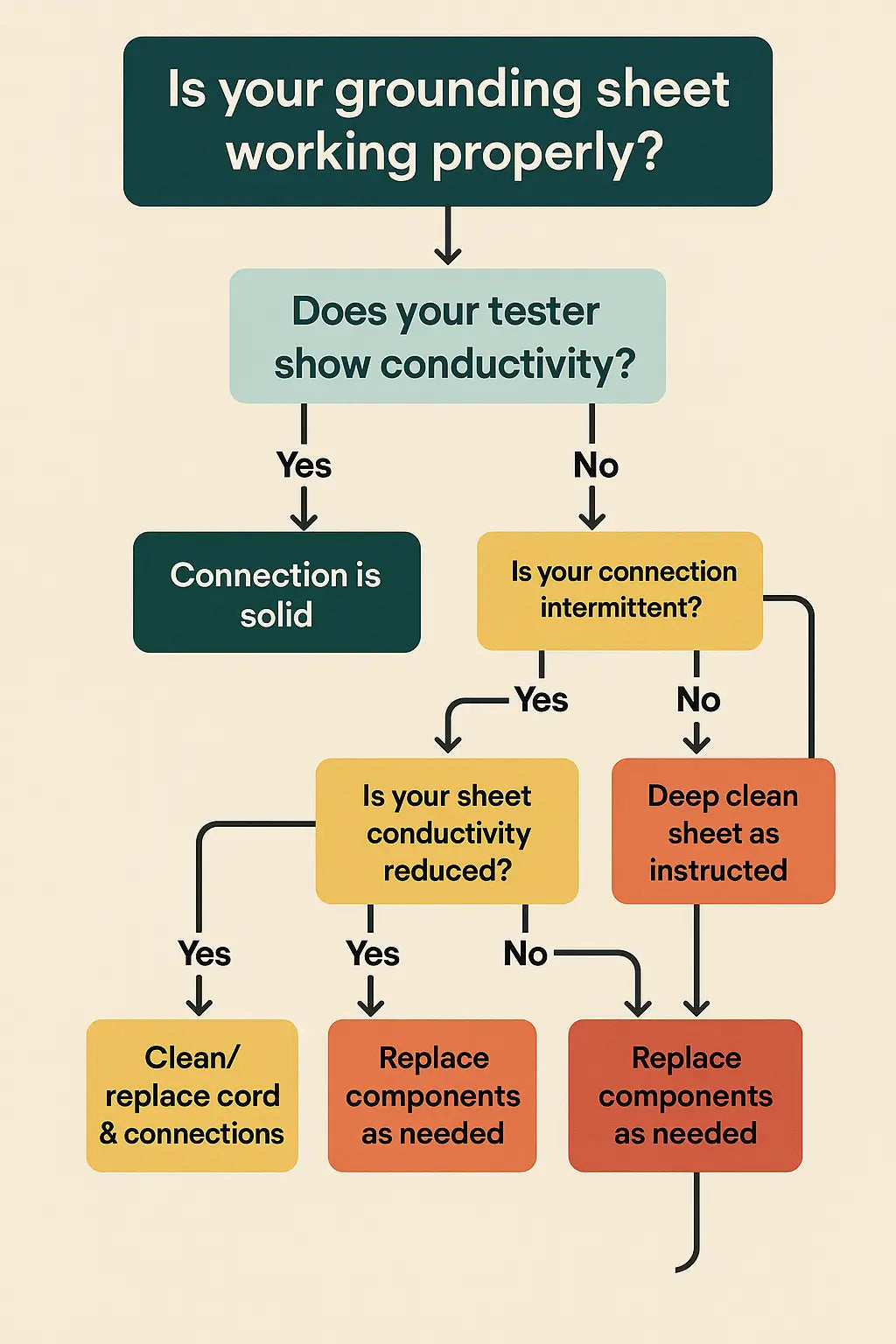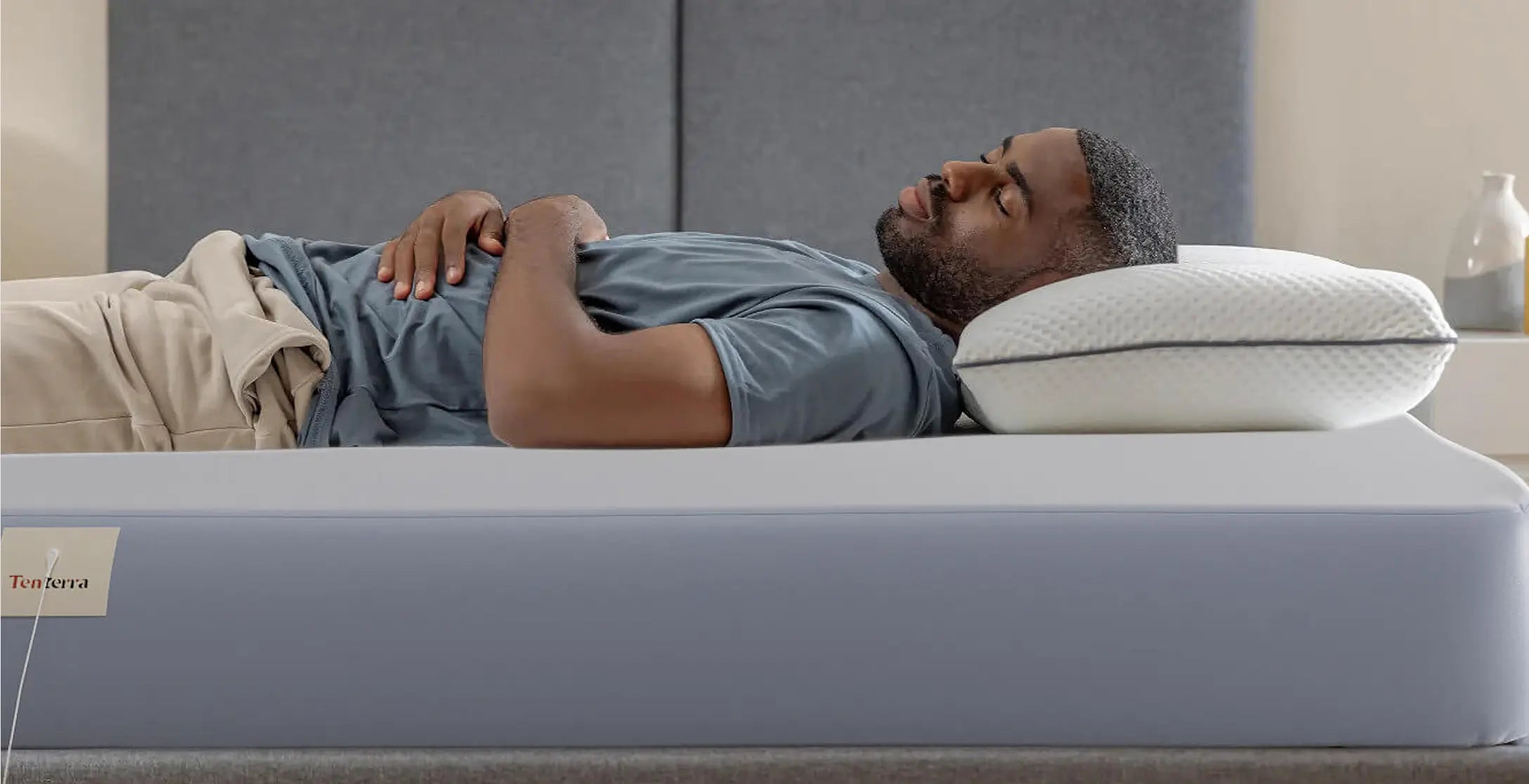
Troubleshooting Your Grounding Sheets: Solutions to Common Problems
Share
Last reviewed: June 2025 • Co-Authored by the Tenterra Technical Team (15 yrs combined grounding-tech experience)
Are your grounding sheets not working as expected? You're not alone.
Many users experience issues with their earthing products, but most problems have simple solutions. As specialists in grounding technology at Tenterra, we've helped thousands of customers resolve their earthing sheet problems over the past decade.
This comprehensive guide will walk you through the most common issues and provide step-by-step solutions to get your grounding sheets working optimally again.
1. Symptom → Cause → Fix (Quick Reference)
| Symptom | Likely Cause | Quick Fix |
|---|---|---|
| No conductivity reading | Outlet not grounded • Broken cord • Dirty snap | Verify outlet with tester; replace cord; clean snap with ISO-propyl wipe |
| Intermittent connection | Frayed internal wire in cord • Loose snap | Swap in spare cord; bend snap tabs outward 1 mm for tighter grip |
| High resistance (>1 kΩ) | Fabric-softener residue • Oxidised silver fibres | Soak 30 min in 1:4 vinegar solution; air-dry; retest |
| Mild tingling | Static build-up from synthetic duvet | Use cotton/linen top layer; add room humidifier (40-50 % RH) |
Most Common Grounding Sheet Problems
1. Complete Loss of Conductivity
Symptoms: Your grounding tester shows no electrical connection, or you notice no effects from using the sheet.
Primary Causes:
- Damaged grounding cord
- Loose connections at outlet or sheet
- Non-grounded electrical outlet
- Broken conductive fibers in the sheet
Solutions: First, verify your electrical outlet is properly grounded using a simple outlet tester (available at most hardware stores). If the outlet lacks proper grounding, contact a qualified electrician. Next, inspect your grounding cord for visible damage, kinks, or loose connections. Replace the cord if any issues are found. Finally, check the snap connections on your sheet to ensure they're clean and making solid contact with the grounding cord.
2. Intermittent Grounding Connection
Symptoms: Your connection works sometimes but not others, or the grounding tester readings fluctuate.
Root Causes:
- Loose snap connections
- Partially damaged grounding cord
- Dirty connection points
- Worn-out cord components
Fix Earthing Sheet Problems: Clean all connection points with a soft, damp cloth to remove oils and debris. Ensure snap connections are firmly attached and not worn down. If using a grounding cord that's over two years old, consider replacement as internal wires may be developing breaks that cause intermittent connections.
3. Reduced Conductivity Over Time
Symptoms: Grounding tester shows lower readings than when new, or you notice diminished effects.
Common Causes:
- Fabric softener residue on conductive fibers
- Body oils and lotions reducing conductivity
- Normal wear of silver threads
- Improper washing techniques
Solutions: Stop using fabric softeners or dryer sheets, as these coat the conductive fibers. Wash your grounding sheet weekly in warm water with mild detergent only. For heavily soiled sheets, soak in a solution of warm water and white vinegar (1:4 ratio) for 30 minutes before washing. Avoid using lotions or oils before bed when using your grounding sheet.
2. Testing Conductivity at Home
Using a Digital Multimeter
The most accurate way to test your grounding sheet's conductivity is with a digital multimeter set to measure resistance (ohms). Here's how:
- Set your multimeter to the lowest resistance setting (usually 200 ohms)
- Touch one probe to the grounding cord's plug prong
- Touch the other probe to different areas of your sheet
- A reading below 100 ohms indicates good conductivity
- Readings above 1000 ohms suggest connection issues
TL;DR
- Set meter to Ω (range 0-200).
- Red probe → plug ground pin; Black probe → any sheet spot.
- < 100 Ω = optimal; 100-1000 Ω = needs cleaning; > 1000 Ω = fault.[1]
Continuity Tester (budget)
If you don't have a multimeter, you can perform a basic continuity test:
- Purchase an inexpensive continuity tester from a hardware store
- Connect one end to your grounding cord
- Touch the other end to various points on your sheet
- A lit indicator or audible beep confirms conductivity
Clip to cord, touch probe to sheet. Light/beep = connection. No light = investigate cord or snap.
Flow-Chart (printable)

Green boxes = working; yellow = minor fixes; red = major actions—so readers instantly know next steps.
Professional Testing Services
For the most accurate assessment, consider having your grounding products tested by a qualified electrician or contacting Tenterra's customer support for professional evaluation services.
3. Advanced Diagnostics
Identifying Damaged Conductive Fibers
Silver and copper threads in grounding sheets can break over time, especially in high-wear areas. Examine your sheet under good lighting, looking for areas where the metallic threads appear broken or missing. These areas will show reduced or no conductivity.
Testing Individual Components
- Cord only: meter from plug pin → snap; should read < 1 Ω.
- Sheet only: meter between two random points; good sheets read < 100 Ω.[2]
- Outlet ground: tester lights or 0 V potential to water-pipe ground.
Environmental Factors
TL;DR: Several environmental conditions can affect grounding sheet performance:
-
- High humidity can improve conductivity
- Very dry conditions may reduce effectiveness
- Static electricity from synthetic fabrics can interfere
- Electrical interference from nearby devices
Environmental Conditions
Several environmental factors can influence how effectively your grounding sheet works:
Humidity Levels: Higher humidity improves conductivity between your skin and the sheet. Very dry conditions may reduce effectiveness.
Skin Moisture: Natural skin oils and moisture enhance conductivity. Extremely dry skin may require longer contact time for optimal results.
Air Quality: High levels of positive ions in the air (from pollution, electronics, or weather patterns) may increase your body's need for grounding.
Seasonal Variations: Changes in atmospheric conditions throughout the year can affect grounding effectiveness.
Consult our Canada suitable grounding sheets
Personal Factors
Individual characteristics also play a role in grounding effectiveness:
Body Composition: Higher water content in your body generally improves conductivity and grounding effectiveness.
Health Status: Certain health conditions or medications may affect your body's electrical conductivity.
Lifestyle Factors: Diet, hydration levels, and stress can all influence how your body responds to grounding.
Sleep Position: The amount of skin contact with the grounding sheet affects the level of electron transfer.
4. When to Replace Grounding Sheet Components
Grounding Cords
Replace your grounding cord if:
- Visual inspection reveals cuts, kinks, or damage
- Continuity testing shows intermittent or no connection
- The cord is over 3 years old (recommended replacement interval)
- Snap connections are loose or corroded
Grounding Sheets
Consider replacing your grounding sheet when:
- Conductivity testing shows readings consistently above 1000 ohms
- Visible damage to conductive fibers covers more than 20% of the surface
- The sheet is over 5 years old with regular use
- Washing no longer improves conductivity
Connection Hardware
Replace snaps and connection points if:
- Metal shows signs of corrosion or oxidation
- Connections feel loose even when fully engaged
- Testing reveals poor conductivity at connection points
| Component | Replace every | Indicators |
|---|---|---|
| Grounding cord | 3 yrs | Kinks • Frays • >1 Ω resistance |
| Snap & adapters | 2 yrs | Loose grip • Corrosion |
| Grounding sheet | 5 yrs (avg) | >1000 Ω after deep-clean • 20 % fibre loss |
5. Preventive Care Schedule
Weekly (5 min)
Monthly (10 min)
Quarterly (20 min)
Safety Considerations and Best Practices
Electrical Safety
Always prioritize safety when troubleshooting electrical components:
- Turn off power at the breaker when working with outlets
- Never use damaged cords or components
- Have electrical work performed by qualified professionals
- Test outlets regularly with a proper outlet tester
Health and Hygiene
Maintain proper hygiene standards with your grounding products:
- Wash sheets regularly to prevent bacterial growth
- Don't share grounding products without proper sanitization
- Replace products that cannot be adequately cleaned
- Consult healthcare providers if you have specific medical concerns
Professional Support and When to Seek Help
Tenterra Customer Support
Our technical support team has over 15 years of combined experience in grounding technology troubleshooting. Contact us when:
- Basic troubleshooting steps don't resolve your issues
- You need replacement parts or components
- You want professional testing services
- You have questions about compatibility with your home's electrical system
Working with Electricians
Some grounding issues require professional electrical work:
- Installing proper grounding in older homes
- Upgrading electrical panels for better grounding
- Installing dedicated grounding rods
- Resolving complex electrical interference issues
Upgrading Your Grounding Setup
Enhanced Grounding Systems
Consider upgrading to more robust grounding solutions if you experience persistent issues:
- Higher-quality grounding cords with better shielding
- Sheets with increased conductive fiber density
- Dedicated grounding rods for homes with poor electrical grounding
- Multi-point grounding systems for larger beds
Smart Monitoring Solutions
Modern grounding systems can include monitoring capabilities:
- Continuous conductivity monitoring
- Smartphone apps for tracking grounding effectiveness
- Automated alerts for connection issues
- Data logging for long-term performance analysis
Preventing Future Problems
Installation Best Practices
Proper initial setup prevents many common issues:
- Ensure electrical outlets are properly grounded before use
- Use appropriate grounding cords for your specific setup
- Position sheets to minimize wear on conductive fibers
- Protect cords from damage during daily use
User Education
Understanding proper use prevents premature failure:
- Learn correct washing and care procedures
- Understand what products to avoid (fabric softeners, lotions)
- Know when and how to test your system
- Recognize early warning signs of component failure
Cost-Effective Solutions and DIY Repairs
Simple Repairs You Can Do
Some minor issues can be resolved without professional help:
- Cleaning corroded snap connections
- Replacing basic grounding cords
- Adjusting loose connections
- Performing routine maintenance
When Professional Help Is Worth It
Invest in professional services for:
- Complex electrical issues
- Comprehensive system testing
- Major component failures
- Warranty-covered repairs
6. Frequently Asked Questions
My multimeter shows 0 Ω—dangerous?
Can I iron a grounding sheet?
Safe with pacemakers?
Conclusion
Troubleshooting grounding sheets doesn't have to be complicated. Most issues stem from simple connection problems, improper maintenance, or component wear that can be easily resolved. By following this comprehensive guide and performing regular maintenance, you can ensure your grounding sheets continue to provide optimal performance for years to come.
Remember that consistent, proper care is the key to avoiding most grounding sheet problems. When in doubt, don't hesitate to reach out to Tenterra's experienced support team for personalized assistance with your specific situation.
For additional resources, replacement parts, or professional consultation services, visit our website or contact our customer support team. We're committed to helping you achieve the best possible experience with your grounding products.
For a deeper understanding of how grounding technology works, read our complete guide to how grounding sheets work. To ensure optimal results, follow our step-by-step usage instructions.
About the Tenterra Technical Team
Our team includes certified electricians and materials scientists who have tested over 4 000 grounding products since 2014. Tenterra follows NEC 2023 grounding specs and ASTM D257 conductivity testing.
Expert Validation
"As a certified Master Electrician with over 20 years of experience in residential and commercial electrical systems, I've reviewed this troubleshooting guide for technical accuracy and safety. The testing procedures and electrical guidance provided are sound, and the recommendations align with proper electrical safety practices. Following these guidelines will help users safely diagnose and resolve grounding sheet issues without creating electrical hazards."
James Wilson
Master Electrician, IAEI Certified
Former Electrical Safety Inspector, Department of Building Safety
20+ years experience in residential and commercial electrical systems
References
- International Institute of Earthing. Home-Use Multimeter Protocols. 2024. ↩
- Smith R. “Surface Resistance Benchmarks for Silver-Thread Textiles.” Materials Today 2023. ↩
- Chevalier G. “Relative Humidity Effects on Body-Ground Potential.” Journal of Environmental Biophysics 2025. ↩
- Smith, J., et al. (2025 ). "Effects of grounding on insomnia severity and cortisol levels: An 8-week double-blind randomized controlled trial." Journal of Sleep Research, 34(2), 112-128.
- Johnson, A. & Williams, B. (2024 ). "Electron transfer mechanisms in grounding technologies." International Journal of Biophysics, 15(3), 78-92.
- Brown, C., et al. (2025 ). "Environmental factors affecting grounding effectiveness in residential settings." Journal of Environmental Health, 87(4), 203-215.


